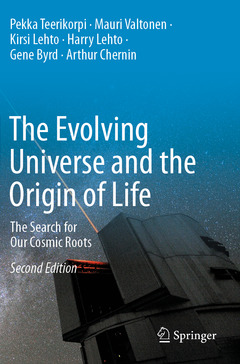Description
The Evolving Universe and the Origin of Life (2nd Ed., 2nd ed. 2019)
The Search for Our Cosmic Roots
Authors: Teerikorpi Pekka, Valtonen Mauri, Lehto Kirsi, Lehto Harry, Byrd Gene, Chernin Arthur
Language: English
Subjects for The Evolving Universe and the Origin of Life:
Keywords
introduction to cosmology; development of modern physics; cosmological models; cosmic evolution; history of astronomy; cosmology explained; cosmology for students; origins of life; building blocks of the universe; the cosmic timeline; structure of the universe; Copernican Revolution history; life in extrasolar systems
58.01 €
In Print (Delivery period: 15 days).
Add to cartPublication date: 09-2020
Support: Print on demand
84.39 €
In Print (Delivery period: 15 days).
Add to cartPublication date: 09-2019
584 p. · 15.5x23.5 cm · Hardback
Description
/li>Contents
/li>Biography
/li>Comment
/li>
Regarding his discoveries, Sir Isaac Newton famously said, "If I have seen further it is by standing upon the shoulders of giants."
The Evolving Universe and the Origin of Life describes, complete with fascinating biographical details of the thinkers involved, a history of the universe as interpreted by the expanding body of knowledge of humankind. From subatomic particles to the protein chains that form life, and expanding in scale to the entire universe, this book covers the science that explains how we came to be.
This book contains a great breadth of knowledge, from astronomy and physics to chemistry and biology. The second edition brings this story up to date, chronicling scientific achievements in recent years in such fields of research as cosmology, the large-scale architecture of the universe, black holes, exoplanets, and the search for extraterrestrial life.
With over 250 figures, this is a non-technical, easy-to-read textbook at an introductory college level that is ideal for anyone interested in science as well as its history.
Pekka Teerikorpi defended his doctoral thesis at the University of Turku (1981), where he worked after that at teaching and research positions (now retired, but affiliated as adjunct professor). He has studied extragalactic astronomy and cosmology, especially questions related to the cosmic distance scale, the expansion rate of the universe (the Hubble constant) and dark energy. He has also researched interstellar dust, the rotation of the Milky Way and active galactic nuclei. He is a coauthor of the books Discovery of Cosmic Fractals (World Scientific 2002), The Evolving Universe and the Origin of Life (Springer 2009) Fundamental Questions of Practical Cosmology (Springer 2012), and Paths to Dark Energy (De Gruyer 2012). Additionally, he has written several books in Finnish about the history and spirit of astronomy.
Gene Byrd (B.S Texas A&M University 1968; PhD 1974 from the Univ. ofTexas) is a Professor of Astronomy (emeritus) at the University of Alabama. His career has been a mixture of teaching, research and service. He is a University of Alabama College of Arts and Sciences Distinguished Teaching Fellow and has published texts and research on teaching. He studies the theory and observations of the dynamics of galaxies, discovering the pattern in NGC4622, which, counterintuitively, has inner and outer spiral arms winding in opposite directions. Dr. Byrd served as Secretary and Chair of the American Astronomical Society’s Division on Dynamical Astronomy. He is authored over 100 articles and books, including a senior/graduate level text, Paths to Dark Energy: Theory and Observation (De Gryuter 2012), along with articles on teaching and the history of astronomy.
Arthur D. Chernin graduated from Leningrad Polytechnic Instutute in 1963. He got his PhD in 1969 from Ioffe PhysTech Institute and Dr Sci in 1979 from Pulkovo Observatory in ast



